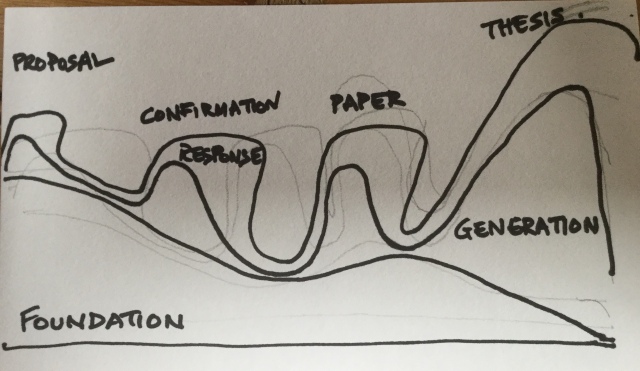 |
| world.edu |
Dear Readers. Shaun Lehmann, Katherine Firth (of the Research Voodoo blog) and I are currently in the process of writing a new book for Open University Press called ‘Writing Trouble’.
The proposed book evolved out of our work on the Thesis Bootcamp program, a writing intervention originally designed by Peta Freestone and Liam Connell.
Over the years all of us have been running our own bootcamps we have met hundreds of students struggling to put their final thesis draft together. These students have supervisors who are clearly great researchers, but cannot give good feedback on writing. The book works backwards from the confusing feedback students have showed us. ‘Writing Trouble’ will help you diagnose and treat your thesis writing problems.
Part of our process with this new book is to test out some of our text on our audience – you. If you’d like to know more about the book before it’s published, you can sign up for our writing trouble mailing list. Here is the first post on ‘vagueness’ by Shaun – he’s interested to see if it’s too… vague. Take it away Shaun!
Research students often receive comments like these:
- I’m not sure what you are trying to say here
- Do you mean x, or y?
- What is ‘it’?
- Be more specific
Reading this feedback can be an incredibly frustrating experience. You thought had been crystal clear – why can’t your supervisor understand? Did they read it in the dark?
Unfortunately, it’s far more likely that your writing was suffering from ‘vagueness’ – a constant problem in English. English-speaking readers (especially in an academic context) will only do a very small amount of work to figure out what you mean before they respond with confusion. I’ve spent a lot of time with research students for whom English is a second/other language. Vagueness is an especially common for this group of PhD students, but it also plagues less experienced writers. Why does it happen?
When you level up to a research degree, there is increased scrutiny of your work. A big part of communicating successfully in academic English depends on your ability to identify and eliminate multiple meanings from your text. Surprisingly, once you learn how to do it, dealing with vagueness in your text can actually be very enjoyable, in addition to making you a better writer and editor.
Before I go on to explain some techniques to deal with vagueness, it is important to understand why the English language behaves the way it does when there is ambiguity. For this, I will turn to the work of the late anthropologist Edward T. Hall and his concept of high- and low-context cultures.
In essence, a high-context culture is one in which a listener/reader is comfortable making use of contextual information and applying their common sense in order to understand messages. These languages developed in tight knit communities who shared a lot of experiences in common. You can think about a high context language as being full of ‘insider speak’.
For instance, it’s likely that you understand cultural references and memes that completely mystify your parents. In a high context language you can take a lot for granted and don’t have to explain yourself. You may also see cultural communication styles like this referred to as listener/reader responsible. As it happens, some of the most common first languages of students writing in English are derived from high-context environments: Chinese, Korean, Japanese, Indonesian, Thai, Arabic, and to some extent Spanish and French.
On the other hand, a low-context culture relies much more so on the content of the message. Low context languages developed in situations where people living next to each other were different – such as in trading ports and countries that have been repeatedly colonised – such as England was for thousands of years. Waves of invaders: Romans, Vikings, the Normans disrupted the close bonds of society and this meant people had to work hard to understand each other.
In a low context language the recipient of the communication brings very little to the table in terms of securing understanding. The onus is on you to make yourself understood. These cultures are also therefore referred to as speaker/writer responsible. This communication style is especially common to the Germanic cultures of Northern Europe, and therefore to English as well.
Let me give you a small example of how this difference in context-reliance plays out in everyday speech, taking Japanese (high-context) and English (low-context) as our languages of comparison. Let us imagine two people stepping outside on a cold day. In Japanese, you can express that you feel cold by simply saying ‘cold’ – the listener will look at the situation at hand, understand that the weather is cold, and then guess that what you mean is that you feel cold.
In English, you need to do much more work. If you just say ‘cold’, your listener will probably respond with ‘what’s cold?’. This is because the listener in this case is not as comfortable with guessing what you mean based on context and common sense. For this listener, it is not possible to know whether you meant ‘I feel cold because the weather is cold’ or whether you meant ‘I’d like to direct your attention to the fact that the weather is cold, though I myself am not bothered by it’. Further, it actually isn’t even completely clear whether you are talking about yourself, as you haven’t said ‘I’. This is why in English we must say ‘I’m cold’ or ‘it’s cold’, if we hope to be reliably understood.
Stay with me – I will give a more academic example later.
As we can see, the English speaking listener (and by extension reader), is likely to be confused if there is more than one meaning implied in any statement. A useful way of thinking of this is that English speakers interpret communications on a possibility basis and not on a probability basis. Being 80% sure that you meant xis not acceptable, as there is still a possibility that you meant y. A successful English-language communication is one that has only one possible meaning.
So returning to the common (annoying) feedback at the top of this post, if you are being told that you are being vague, it means that you are writing in a higher-context mode than the reader and asking them to be probabilistic where they want more certainty.
How to Deal with Vagueness
Dealing with vagueness is about learning to ‘get out of your own head’. As I have implied, context-dependency issues can arise for writers with English as a second/other language, but they can also occur for native speakers who are simply too close to their work (a common problem for thesis students).
A useful technique is to learn to read your work through the eyes of a kind of caricature of the low-context communication mode. You need to imagine a reader who is highly intelligent and logical, but who has no common sense and will fail to interpret any multiple meaning in the way you had intended.
I call my version of this the Commander Data Meditation based on the robotic Star Trek character of the same name, but it works just as well to imagine Sheldon Cooper from the Big Bang Theory or any other hyper-logical character.
This technique is best used in combination with what I call the 48-Hour Rule. After you have finished writing, put aside your work for 48 hours. This is long enough to forget the exact words you chose, but to recall exactly what you meant to say. Sit down with your work, close your eyes, and put yourself into the mode of the character that works for you.
First warm yourself up with some simpler (and more humorous) examples. For each of the below, identify the multiple meanings, and then re-write them to make these multiple meanings clear.
Here’s an example:
- During the incident, the defendant struck the man with a walking stick.
- During the incident, the defendant used a walking stick to strike the man.
- During the incident, the defendant struck the man who was holding a walking stick.
Now try the following:
- The star was observed with a telescope.
- I saw the tree coming around the hill.
- It is widely acknowledged that flying planes can be dangerous.
- I shot an elephant in my pyjamas.
Here is an example based on a real thesis:
“Some recommendations are still relevant and can be implemented. Most of the recommendations were related to project management, public debt management, budgetary reforms and financial sector reforms.”
In this case, two sets of recommendations are identified in the first sentence, 1) all recommendations, and 2) the recommendations that are relevant to be implemented. While it may have been perfectly clear to the writer that they were referring to 2) when they said ‘Most of the recommendations …’ in the second sentence, in my low-context mode it becomes clear that the writer could actually be pointing to either set of recommendations. I would then edit the text as such to remove this second meaning:
“Some recommendations are still relevant and can be implemented. Most of thesestill relevant recommendations were related to project management, public debt management, budgetary reforms and financial sector reforms.”
Now, go back to your thesis. As you read, try to identify where anything you are saying might be interpreted as having more than one meaning. Treat for vagueness as you have above.
While it can be frustrating to be told that you have vagueness issues, I think you can see how the fix is quite simple. The key is to remember that you aren’t writing for a clone of yourself, with all of your knowledge and experiences. Nor are you writing for someone who can be relied upon to ‘fill in the gaps’ in what you have said.


